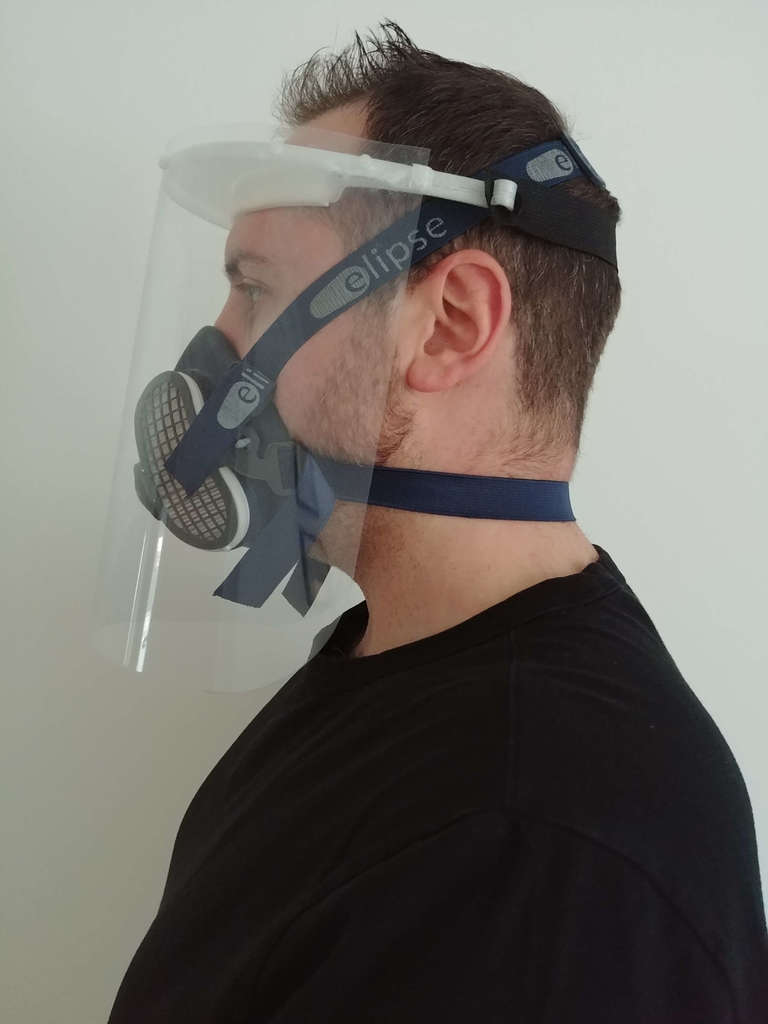
COVID-19 Lightweight 3D Printable Face Shield
thingiverse
WARNING: No claims are made about the accuracy and/or safety of this device. Make and/or use at your own risk. UPDATE (10/04/2020): A 6-Pin variant has been added that offers better protection due to its deeper visor, which measures approximately 38mm or 1 1/2" either side. This version can be made from one piece of A3 acetate, just like the original design. UPDATE (04/04/2020): All parts of the face shield that may come into contact with the wearer's head now meet the minimum requirements of EN 166:2001, which mandates a width of at least 10.2mm for headbands. This simple face shield is based on the innovative design created by Hong Kong Polytechnic University (PolyU) in collaboration with Queen Elizabeth Hospital and the Hong Kong Hospital Authority. The frame comes in two versions: a 4-pin version and a 6-pin version, which offers a deeper visor that wraps around further. Retaining arms on either side of the frame ensure that the visor stays firmly attached, providing protection all the way to the temples and beyond. The visor sits approximately 38mm (1 1/2"), away from the face, leaving enough space for a low-profile half-mask respirator if desired. An elastic band is all you need for a strap, and self-adhesive foam provides comfort. The shield has been designed to provide a close fit for a European head shape (intermediate cephalic index), optimized for 55-57cm head circumference (average female and male respectively, UK). By design, the maximum head circumference that can be accommodated is 60cm. 53cm is the smallest head circumference that has been tested so far, but the design may also accommodate smaller heads. Both designs use under 11m of filament and take around 3 hours to print. The single-piece print fits on a 200mm x 200mm print bed (actual size approx. 184mm x 177mm). Comfort is provided via draught excluder foam, which is readily available online and very cheap. The visor is made from a single piece of A3 acetate, although the frame itself can hold thicker material if you prefer to use something different, such as PET. The design is flat so it should be relatively straightforward to CNC or laser cut. You will need a template for the visor, which can be created by folding a piece of paper in half length-ways and drawing lines on the crease to mark the centre and outer edges. To make a template for the 4-pin visor: Fold the piece of A4 paper in half length-ways to find the centre and draw a line on the crease to make it visible. Measure and draw a line 80mm in each direction from the centre. Line the length of the A4 paper along the width of the A3 acetate, with the lines on the outer edge. You need to punch twice, lining the centre of the punch with each outer line. You now have your 4 holes. To make a template for the 6-pin visor: Fold the piece of A3 paper in half length-ways to find the centre and draw a line on the crease to make it visible. Measure and draw a line 80mm in each direction from the centre. Draw another line 120mm in each direction from the centre. You need to punch four times, lining up the centre of the punch with the four lines you measured. 6-Pin Visor: Trim 23mm from each side so the total width is now 374mm. You now need to trim the visor to length. I personally found 250mm to be adequate. Measure 250mm down from the side with the holes and use a pair of scissors, or a scalpel to cut it to size. It may also be a good idea to put a radius on the bottom corners to prevent them snagging on things. I used a CD as a template (r = 60mm). Attach the visor to the frame. The hollow part of the frame should not be visible from the outside. Start by placing the edge of the acetate into one of the retaining arms. Now work around the frame from one side to the other, pushing the pins into the holes one at a time. I found it easier to slot the edge of the acetate into the other retaining arm before locating the final pin. Add the strap to the back.
With this file you will be able to print COVID-19 Lightweight 3D Printable Face Shield with your 3D printer. Click on the button and save the file on your computer to work, edit or customize your design. You can also find more 3D designs for printers on COVID-19 Lightweight 3D Printable Face Shield .
